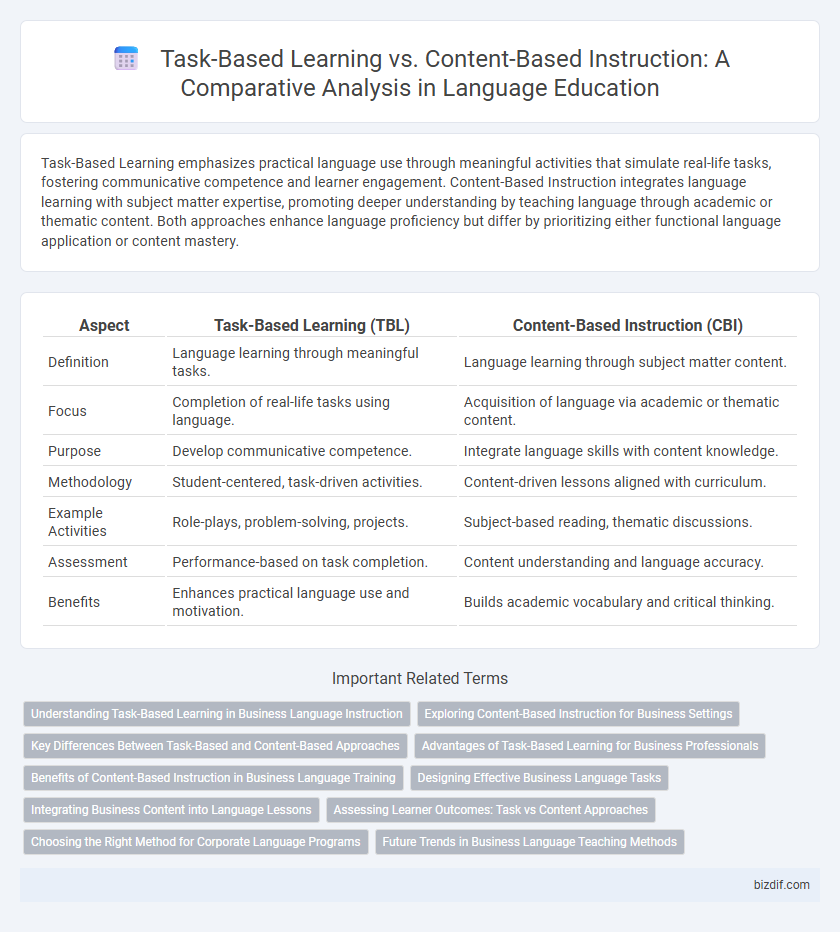Task-Based Learning emphasizes practical language use through meaningful activities that simulate real-life tasks, fostering communicative competence and learner engagement. Content-Based Instruction integrates language learning with subject matter expertise, promoting deeper understanding by teaching language through academic or thematic content. Both approaches enhance language proficiency but differ by prioritizing either functional language application or content mastery.
Table of Comparison
| Aspect | Task-Based Learning (TBL) | Content-Based Instruction (CBI) |
|---|---|---|
| Definition | Language learning through meaningful tasks. | Language learning through subject matter content. |
| Focus | Completion of real-life tasks using language. | Acquisition of language via academic or thematic content. |
| Purpose | Develop communicative competence. | Integrate language skills with content knowledge. |
| Methodology | Student-centered, task-driven activities. | Content-driven lessons aligned with curriculum. |
| Example Activities | Role-plays, problem-solving, projects. | Subject-based reading, thematic discussions. |
| Assessment | Performance-based on task completion. | Content understanding and language accuracy. |
| Benefits | Enhances practical language use and motivation. | Builds academic vocabulary and critical thinking. |
Understanding Task-Based Learning in Business Language Instruction
Task-Based Learning in business language instruction emphasizes completing meaningful, real-world tasks that simulate workplace communication, enhancing practical language skills. This method improves learners' ability to perform specific business activities such as negotiations, presentations, and email correspondence through authentic interaction. By focusing on task completion rather than explicit language rules, it fosters deeper engagement and contextual understanding critical for professional environments.
Exploring Content-Based Instruction for Business Settings
Content-Based Instruction (CBI) in business settings integrates industry-specific materials into language learning, enhancing practical communication skills relevant to professional environments. This approach enables learners to acquire language proficiency while simultaneously gaining knowledge in areas such as management, marketing, and finance. CBI fosters authentic language use through real-world tasks, promoting effective interaction in diverse business contexts.
Key Differences Between Task-Based and Content-Based Approaches
Task-Based Learning emphasizes completing meaningful tasks that simulate real-life language use, focusing on practical communication and interaction. Content-Based Instruction integrates language learning with subject matter content, promoting knowledge acquisition alongside language skills development. The primary difference lies in Task-Based Learning prioritizing language functions through tasks, whereas Content-Based Instruction centers on delivering academic or thematic content to enhance language competence.
Advantages of Task-Based Learning for Business Professionals
Task-Based Learning enhances practical communication skills by simulating real workplace scenarios, enabling business professionals to apply language in authentic contexts. It promotes active problem-solving and collaboration, which are essential for effective negotiations and team interactions. This approach also accelerates fluency and confidence through repetitive, goal-oriented tasks aligned with specific professional objectives.
Benefits of Content-Based Instruction in Business Language Training
Content-Based Instruction (CBI) enhances business language training by integrating relevant industry topics, which boosts learners' motivation and engagement through practical application. It improves language proficiency alongside subject mastery, enabling professionals to communicate effectively in real-world business contexts. Emphasizing authentic materials and situational language use fosters deeper comprehension and retention essential for successful business interactions.
Designing Effective Business Language Tasks
Designing effective business language tasks requires aligning real-world communication goals with task complexity and authenticity, ensuring learners engage in meaningful exchanges such as negotiating contracts, preparing presentations, or drafting emails. Task-Based Learning emphasizes practical, outcome-driven activities that mirror workplace scenarios, enhancing task relevance and learner motivation. Content-Based Instruction integrates business-related topics into language tasks, facilitating simultaneous acquisition of language skills and industry-specific knowledge, improving learners' contextual understanding and professional competence.
Integrating Business Content into Language Lessons
Integrating business content into language lessons through Task-Based Learning (TBL) enhances practical communication skills by engaging learners in real-world business scenarios such as negotiations and presentations. Content-Based Instruction (CBI) emphasizes the acquisition of language through meaningful business topics, fostering deeper comprehension and specialized vocabulary development. Combining TBL's active problem-solving tasks with CBI's thematic content ensures learners gain both functional language proficiency and industry-specific knowledge essential for professional success.
Assessing Learner Outcomes: Task vs Content Approaches
Task-Based Learning assesses learner outcomes through practical language use in real-world scenarios, emphasizing fluency and communicative competence. Content-Based Instruction evaluates understanding and mastery of subject-specific material, integrating language skills within academic or thematic content. Both approaches require tailored assessment methods to accurately measure language proficiency aligned with their distinct instructional goals.
Choosing the Right Method for Corporate Language Programs
Task-Based Learning emphasizes practical communication skills through real-world tasks, making it ideal for corporate programs aiming to enhance employee interaction and problem-solving abilities. Content-Based Instruction integrates language learning with industry-specific materials, fostering deeper subject knowledge alongside language proficiency critical for technical roles. Selecting between these methods depends on corporate goals: prioritize Task-Based Learning for conversational competence and Content-Based Instruction for specialized vocabulary and context mastery.
Future Trends in Business Language Teaching Methods
Future trends in business language teaching emphasize the integration of Task-Based Learning (TBL) and Content-Based Instruction (CBI) to enhance practical communication skills and subject matter expertise. TBL promotes active problem-solving and real-world tasks, while CBI focuses on thematic content relevant to specific industries, fostering deeper language comprehension. Emerging technologies like AI-driven platforms are expected to customize these approaches, improving learner engagement and business relevancy in multilingual environments.
Task-Based Learning vs Content-Based Instruction Infographic

 bizdif.com
bizdif.com